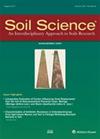土壤中水和二氧化碳之间的氧同位素交换通过与碳酸酐酶活性的联系,受到pH、硝酸盐和微生物生物量的控制
4区 农林科学
Q2 Agricultural and Biological Sciences
引用次数: 2
摘要
摘要大气中二氧化碳(CO2)的氧同位素组成与地球表面二氧化碳和水循环的大规模变化密切相关。了解生物圈在改变大气二氧化碳氧同位素组成中的作用尤为重要,因为这种同位素示踪剂有可能限制对重要过程的估计,如大规模的总初级生产。然而,要限制CO2氧同位素组成的大气质量收支,还需要我们更好地了解土壤群落的贡献,以及它们如何影响各种土壤类型和气气带中土壤水与CO2(kiso)之间氧同位素交换速率。由于碳酸酐酶(CAs)组酶提高了土壤中充满水的孔隙空间内二氧化碳的水化速率,因此了解环境驱动因素如何通过其活性的变化对其产生影响是很重要的。在这里,我们在实验室孵化实验中使用了来自亚洲西部和澳大利亚东北部的44个土壤样本来估计kiso和测量相关的土壤特性。kiso的观测值总是超过理论推导的非催化速率,表明CAs对kiso在研究土壤中的变异性有显著影响。我们确定土壤pH值是变异的主要来源,在碱性条件下,土壤pH值更大,这表明微生物群落组成或细胞内外溶解无机碳梯度的变化诱导了更多或更高活性形式的cas的表达。我们还首次在土壤中表明,在自然酸性条件下硝酸盐的存在会减少kiso,这可能反映了对CAs的直接或间接抑制。在一部分土壤上进行的补充硝酸铵施肥实验似乎支持了这种效应。在给定的化学条件下,更大的微生物生物量也会增加,这突出了CA表达与土壤微生物丰度之间的假定联系。这些数据提供了迄今为止最广泛的土壤kiso空间变化分析,并指出了在大空间尺度上预测kiso变化所需的关键土壤性状数据集,这是约束土壤群落在CO2氧同位素组成大气质量预算中的重要作用的必要下一步。本文章由计算机程序翻译,如有差异,请以英文原文为准。
Oxygen isotope exchange between water and carbon dioxide in soils is controlled by pH, nitrate and microbial biomass through links to carbonic anhydrase activity
Abstract. The oxygen isotope composition of atmospheric carbon dioxide
(CO2) is intimately linked to large-scale variations in the cycling
of CO2 and water across the Earth's surface. Understanding the role
the biosphere plays in modifying the oxygen isotope composition of atmospheric
CO2 is particularly important as this isotopic tracer has the
potential to constrain estimates of important processes such as gross primary
production at large scales. However, constraining the atmospheric mass budget for the oxygen isotope composition of CO2 also requires that we
understand better the contribution of soil communities and how they influence
the rate of oxygen isotope exchange between soil water and CO2
(kiso) across a wide range of soil types and climatic zones. As
the carbonic anhydrases (CAs) group of enzymes enhances the rate of
CO2 hydration within the water-filled pore spaces of soils, it is important to develop understanding of how environmental drivers can impact
kiso through changes in their activity. Here we estimate
kiso and measure associated soil properties in laboratory
incubation experiments using 44 soils sampled from sites across western
Eurasia and north-eastern Australia. Observed values for kiso always exceeded theoretically derived uncatalysed rates, indicating a significant influence of CAs on the variability of kiso across the
soils studied. We identify soil pH as the principal source of variation, with
greater kiso under alkaline conditions suggesting that shifts in
microbial community composition or intra–extra-cellular dissolved inorganic carbon gradients induce the expression of more or higher activity forms of
CAs. We also show for the first time in soils that the presence of nitrate
under naturally acidic conditions reduces kiso, potentially
reflecting a direct or indirect inhibition of CAs. This effect appears to be
supported by a supplementary ammonium nitrate fertilisation experiment
conducted on a subset of the soils. Greater microbial biomass also increased
kiso under a given set of chemical conditions, highlighting a putative link between CA expression and the abundance of soil microbes. These
data provide the most extensive analysis of spatial variations in soil
kiso to date and indicate the key soil trait datasets required to
predict variations in kiso at large spatial scales, a necessary
next step to constrain the important role of soil communities in the
atmospheric mass budget of the oxygen isotope composition of CO2.
求助全文
通过发布文献求助,成功后即可免费获取论文全文。
去求助
来源期刊

Soil Science
农林科学-土壤科学
CiteScore
2.70
自引率
0.00%
发文量
0
审稿时长
4.4 months
期刊介绍:
Cessation.Soil Science satisfies the professional needs of all scientists and laboratory personnel involved in soil and plant research by publishing primary research reports and critical reviews of basic and applied soil science, especially as it relates to soil and plant studies and general environmental soil science.
Each month, Soil Science presents authoritative research articles from an impressive array of discipline: soil chemistry and biochemistry, physics, fertility and nutrition, soil genesis and morphology, soil microbiology and mineralogy. Of immediate relevance to soil scientists-both industrial and academic-this unique publication also has long-range value for agronomists and environmental scientists.
 求助内容:
求助内容: 应助结果提醒方式:
应助结果提醒方式:


